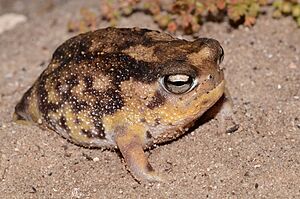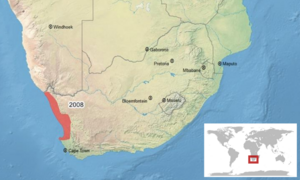Namaqua rain frog facts for kids
Quick facts for kids Namaqua rain frog |
|
|---|---|
 |
|
| Conservation status | |
| Scientific classification | |
 |
The Namaqua rain frog (also called the Namaqua short-headed frog) is a unique type of frog. Its scientific name is Breviceps namaquensis. You can find this special frog in Namaqualand, which is in western South Africa and the very south of Namibia. It belongs to a frog family called Brevicipitidae.
What Does the Namaqua Rain Frog Look Like?
These frogs are quite small. Adult Namaqua rain frogs grow to about 46 mm (1.8 inches) long.
They have a round, squat body. Their head is short and narrow. They have fairly large eyes and a flat face with a small mouth. Their legs are short and stumpy. Unlike some frogs, their fingers and toes do not have webbing or sticky pads.
The top of their body is brown. They have lighter brown or cream patches on their back and sides. Sometimes, these patches join together. The underside of the frog is mostly smooth and white. In some areas, their skin is see-through. The throat might feel bumpy, with dark marks around the jaw. This frog looks very similar to the Desert rain frog.
Cool Habits and Life Cycle
Namaqua rain frogs have interesting ways to protect themselves. If they feel threatened, they can puff up their bodies. They also make a squeaking sound. This helps to scare away predators.
These frogs spend most of their time living underground. They are known as fossorial animals, which means they are good at digging. They usually come out of the ground after it rains. When they surface, they look for insects to eat.
Their breeding season can happen in winter, spring, or summer. The female frog lays her eggs in special chambers underground. These eggs are covered in a thick, jelly-like substance. As the eggs develop into tadpoles, this jelly turns into a fluid. The tadpoles live in this fluid. They get all their food from the egg yolk as they grow. This means they don't need a pond or water to grow. They change directly into tiny frogs right there underground.
Where It Lives and How We Protect It
The Namaqua rain frog lives in sandy areas. These areas are often covered with scrub plants. This type of environment is part of the succulent karoo biome. Because they develop directly from eggs into frogs, they do not need to live near water.
There are many Namaqua rain frogs in their local areas. However, their homes can be lost. This happens because of farms expanding in the southern part of their range. Luckily, these frogs live in several protected areas. This helps to keep them safe.



